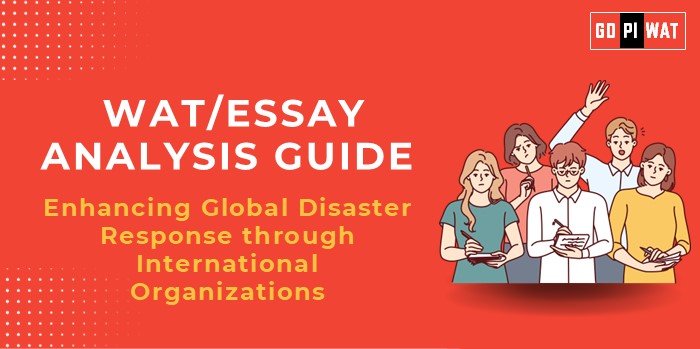📋 Written Ability Test (WAT)/Essay Analysis Guide
🌟 Enhancing Global Disaster Response through International Organizations
🌐 Understanding the Topic’s Importance
Effective disaster response is critical for minimizing human and economic losses, making it a core issue for sustainable development and humanitarian aid. International organizations play a pivotal role in fostering global cooperation to address the growing frequency and severity of disasters.
⏳ Effective Planning and Writing
- ⏱️ Time Allocation:
- Planning: 5 minutes
- Writing: 20 minutes
- Review: 5 minutes
- 📜 Preparation Tips:
- Collect data on disaster trends and global frameworks like the Sendai Framework for Disaster Risk Reduction and the Paris Agreement.
- Study case studies of international disaster responses to highlight successes and areas for improvement.
💡 Introduction Techniques for Essays
- ⚖️ Contrast Approach: “While international organizations have improved disaster response with tools like AI, the persistent funding gap undermines their impact.”
- 🔧 Solution-Based Approach: “To address growing disaster risks, international organizations must evolve through innovation and collaboration.”
📋 Structuring the Essay Body
- 🏆 Achievements:
- Development of early warning systems, significantly reducing casualties during disasters like Cyclone Amphan.
- Global cooperation in disaster relief, such as the coordinated response to the 2004 Indian Ocean tsunami.
- Increased focus on building resilience through frameworks like the Sendai Framework.
- ⚠️ Challenges with Comparative Analysis:
- Funding gaps that hinder timely response, particularly in low-income regions.
- Comparative analysis of Haiti’s earthquake response vs. Japan’s preparedness model highlights disparities in local capacity and readiness.
- 🔮 Future Outlook:
- Encourage private-sector involvement to boost resources and expertise.
- Leverage advanced technologies like AI for better disaster prediction and management.
- Strengthen partnerships between global organizations and local governments to enhance capacity building.
✅ Concluding Effectively
- ⚖️ Balanced Conclusion: “Global disaster response has achieved significant milestones, yet systemic reforms are crucial to address future challenges.”
- 🌍 Global Comparison Conclusion: “International organizations can learn from best practices worldwide, ensuring effective and equitable disaster management.”
📊 Analyzing Successes and Shortcomings
- 🎯 Key Achievements:
- Improved early warning systems that save lives.
- Enhanced coordination among international and regional bodies during crises.
- ⚠️ Ongoing Challenges:
- Lack of local capacity, especially in developing nations.
- Inadequate and delayed funding for disaster relief efforts.
- 🌍 Global Context: “Comparing Japan’s preparedness and Haiti’s recovery struggles highlights the need for tailored solutions that consider local conditions.”
📄 Recommendations for Sustainable Progress
- 🤝 Enhance Resource Pooling: Develop global alliances to pool resources for rapid disaster response.
- 🏫 Strengthen Local Capacity: Implement targeted training programs for disaster management in vulnerable regions.
- 💸 Innovate Funding Mechanisms: Introduce climate insurance and private-sector partnerships to secure sustainable financing.
🖋️ Sample Short Essays
- ⚖️ Balanced Perspective: “While global disaster response has improved, financial constraints and coordination challenges must be addressed to enhance its effectiveness.”
- 💡 Solution-Oriented: “Strengthening partnerships and leveraging AI can transform international disaster response mechanisms.”
- 🌍 Global Comparison: “Drawing lessons from Japan’s preparedness and Haiti’s challenges offers a roadmap for future disaster management improvements.”


